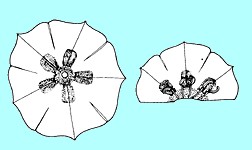 Line drawing by B. Osborn (Flora of Australia, vol. 29) . |
 From Britton & Brown (1898) An Illustrated Flora of the Northern States, Canada and the British Possessions (Charles Scribner's Sons). |

Synonymy
*Physalis philadelphica Lam., Encycl. 2: 101 (1786)
T: Described from cultivated plants; thought to originate from northern America; P n.v.
See discussion by Bean in ASBS Newsletter 127: 8 (2006) on the name of this species.
Description
Annual to 50 cm, sparsely pubescent with simple hairs.
Leaves alternate, 1 or 2 per node (but not opposite); lamina ovate-lanceolate, obtusely cuneate at base, up to 12 (usually c. 6) cm long, sparsely and irregularly toothed; petiole to 7 cm long with a pubescent groove above.
Pedicels 3–13 mm long. Calyx 6–9 mm long; lobes broadly triangular, usually 4–5 mm long. Corolla rotate, 10–15 mm long, yellow with 5 brownish spots alternating with anthers. Anthers 3–4 mm long, twisted after anthesis. Style 8–9 mm long.
Fruiting calyx 10–veined, circular in section or nearly so, 18–36 mm long, yellow-green, the veins often purplish. Berry globular, usually 20–25 mm diam. Seeds broadly reniform, 2–3 mm long, pale yellow-brown.
Distribution and ecology
Uncommon weed, recorded from scattered localities in south-eastern Qld, north-eastern N.S.W., Vic. and south-western W.A.
Common name
Tomatillo
Notes
According to Martinez (1998) P. philadelphica is the only species of Physalis in which the anthers twist after dehiscence. In all other species they remain straight.
A table showing differences between some of the commoner groundcherry species, including this one, can be seen at www.cdfa.ca.gov/phpps/ipc/weedinfo/physalis-table.htm It is occasionally cultivated in Australia.
Martinez, M. (1998). Revision of Physalis Section Epeteiorhiza (Solanaceae). Anales del Instituto de Biologia Universidad Nacional Autonoma de Mexico Serie Botanica 69: 71-117.
Selected specimens
W.A.: Spearwood, 10 Feb. 1961, Major & Son (PERTH). Qld: near Warwick, R. Henderson 360 (BRI). N.S.W.: Border Gate near The Head, L. Bird & K. Williams (BRI 257800). Vic.: near Dimboola, 8 Apr. 1898, F.M. Reader (MEL).
Derivation of epithet
philadelphica, a reference to Philadelphia, source of the plant when first described by Lamarck.
Images and information on web
An excellent series of images of the leaves, fruits and flower can be seen on the Weeds of Mexico site.
Information on this species in NSW can be seen on the PlantNet site at http://plantnet.rbgsyd.nsw.gov.au/cgi-bin/NSWfl.pl?page=nswfl&lvl=sp&name=Physalis~philadelphica
Information about the possible toxic properties of Physalis species can be found with a search in the FDA Poisonous Plant Database